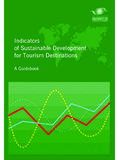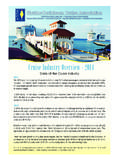Transcription of Geography of Tourism - Encyclopedia of Life Support Systems
1 UNESCO EOLSSSAMPLE CHAPTERSGEOGRAPHY Vol. II - Geography of Tourism - Hall Encyclopedia of Life Support Systems (EOLSS) Geography OF Tourism Hall University of Otago, Dunedin, New Zealand Keywords: Tourism , recreation, leisure, Geography , sustainability, space, place, coastal areas, environment, social, economy, politics, planning, impacts, temporary mobility, transport, technology Contents 1. Introduction 2. Defining Tourism 3. The Development of the Geography of Tourism 4. Demand for Tourism 5. Tourism Supply 6. Impacts of Tourism 7. Tourism Planning 8. Trends for the Twenty-first Century Glossary Bibliography Biographical Sketch Summary Tourism is one of the world s largest industries. It has now become the subject of a specific sub-discipline of Geography . The field has grown substantially since the early 1970s and encompasses a range of different traditions and approaches, including regional Geography , spatial analysis, humanistic Geography , applied Geography , behavioral Geography and more recent concerns surrounding issues of identity, globalization, political economy and encounters with space.
2 The specific characteristics of Tourism as a partially industrialized form of temporary mobility have encouraged geographers to examine issues of demand and supply for Tourism with particular focus on the patterns of Tourism production and consumption, the spatial fixity of Tourism product and the role of seasonality in Tourism . Major concerns also include the number of negative social and environmental impacts that have accompanied rapid Tourism development in some locations although the economic and employment benefits of Tourism are often held in a positive light. Attempts to provide better-balanced Tourism development have led to the development of Tourism planning approaches by geographers who have increasingly recognized the importance of sustainable development as an overarching value system for Tourism . However, implementation of such strategies has proven to be difficult.
3 Nevertheless, the dependence of Tourism on high quality environments in order to attract tourists has meant public-private sector cooperation in sustainable Tourism has become more important than ever. UNESCO EOLSSSAMPLE CHAPTERSGEOGRAPHY Vol. II - Geography of Tourism - Hall Encyclopedia of Life Support Systems (EOLSS) 1. Introduction Tourism is widely recognized as the world s largest industry. For the year 2000, world international Tourism arrivals were estimated by the WTO to have reached million international visitor arrivals with world Tourism growing by an estimated % (Table 1). In 2000 receipts from international Tourism grew to US$476 billion, an increase of % over the previous year. In the same year the travel and Tourism industry constituted 11 % of global GDP (US$3,575 billion); and supported 200 million jobs worldwide; representing 8 % of total employment or 1 in every jobs.
4 It has been estimated that by 2011, the travel and Tourism economy will constitute 11 % of global GDP; Support 260,417,000 jobs worldwide, representing 9 % of total employment or 1 in jobs. However, Tourism , tourists, and their impacts, are clearly not evenly distributed. Substantial differentiation occurs at a variety of international, regional and local scales. The Asia-Pacific region has been the fastest growing area for international travel since the early 1980s although developed regions, such as Europe, still dominate international tourist arrivals. Geographers have sought to understand these spatial and temporal differences as well as the associated economic, political, social and environmental dimensions of the impacts associated with Tourism . Because of these Tourism has been discovered by geographers and other social scientists in the late 1980s and 1990s.
5 Tourism is utilized by government to respond to the effects of global economic restructuring and increasing concerns over conserving the environment. Years Total % change over (Thousands) previous year 1950 25 282 - 1960 69 320 1965 112 863 1970 165 787 1975 222 290 1980 286 249 1985 329 538 1990 459
6 212 1995 561 027 2000 698 300 2010 1,006 400 2020 1 561 100 * WTO forecasts as of 2001 Table 1: International tourist arrivals and WTO forecasts 1950-2020 2. Defining Tourism One of the key issues associated with the study of Tourism is the difficulty of defining the field of enquiry and the extent of overlap with other areas of analysis. Tourism is a form of leisure-oriented temporary mobility with both spatial and temporal dimensions. Temporally Tourism is usually defined technically in relation to length of time away UNESCO EOLSSSAMPLE CHAPTERSGEOGRAPHY Vol. II - Geography of Tourism - Hall Encyclopedia of Life Support Systems (EOLSS) from home environment, while some definitions also incorporate a spatial or distance function in terms of distance from the home environment.
7 The international standard definition of Tourism is that of the WTO which states that Tourism comprises the activities of a person traveling outside his or her usual environment for less than a specified period of time and whose main purpose of travel is other than the exercise of an activity remunerated from the place visited : where usual environment is intended to exclude trips within the areas of usual residence and also frequent and regular trips between the domicile and the workplace and other community trips of a routine character; where less than a specified period of time is intended to exclude long-term migration; and exercise of an activity remunerated from the place visited is intended to exclude only migration for temporary work. The WTO recommended that an international tourist be defined as a visitor who travels to a country other than that in which he/she has his/her usual residence for at least one night but not more than one year, and whose main purpose of visit is other than the exercise of an activity remunerated from within the country visited ; and that an international excursionist, for example cruise ship visitors, be defined as a visitor residing in a country who travels the same day to a country other than which he/she has his/her usual environment for less than 24 hours without spending the night in the country visited and whose main purpose of visit is other than the exercise of an activity remunerated from within the country visited.
8 Similar definitions were also developed for domestic tourists, with domestic tourists having a time limit of not more than six months. Such definitions are important as they serve to distinguish Tourism activity from other forms of temporary mobility such as migration. However, it should be noted that there are a number of forms of temporary mobility such as travel for education, working holidays, and short-term work visas which share a number of characteristics with Tourism . Given changes in transport technology, same-day travel is also becoming increasingly important to some countries. Therefore there is increasing international agreement that Tourism also refers to all activities of visitors, including both overnight and same-day visitors. Such definitional issues are significant because of the potential impact of tourists and daytrippers/excursionists, who are also often described as recreationists.
9 Tourism , recreation and leisure are generally seen as a series of interrelated and overlapping concepts. The concept of leisure is generally used as a period of time, activity or state of mind in which choice is the dominant feature; in this sense leisure is a form of free time for an individual; as an objective view in which leisure is perceived as the opposite of work and is defined as non-work or residual time; and from a subjective view which emphasizes leisure as a qualitative concept in which leisure activities takes on a meaning only within the context of individual perceptions and belief Systems and can therefore occur at any time in any setting. Figure 1 illustrates the relationships between leisure, recreation and Tourism which indicate the value of viewing Tourism and recreation as part of a wider concept of leisure. Work is differentiated from leisure with there being two main realms of overlap: first, business travel, which is seen as a work oriented form of Tourism in order to differentiate it from leisure based travel; second, serious leisure, which refers to the breakdown between leisure and work pursuits and the development of leisure career UNESCO EOLSSSAMPLE CHAPTERSGEOGRAPHY Vol.
10 II - Geography of Tourism - Hall Encyclopedia of Life Support Systems (EOLSS) paths with respect to hobbies and interests. Such differentiation between activities is important for statistical as well as conceptual purposes. Figure 1: Relationships between leisure, recreation and Tourism Traditionally, Tourism was regarded as a commercial economic phenomenon rooted in the private domain. In contrast, recreation and leisure was viewed as a social and resource concern rooted in the public domain. Outdoor recreation studies have historically focused on public-sector ( community and land management agencies) concerns, such as wilderness management, social carrying capacity, and non-market valuation of recreation experiences. In contrast, Tourism tended to have a more applied industrial orientation which concentrated on traditional private-sector ( Tourism industry) concerns, such as the economic impacts of travel expenditures, travel patterns and tourist demands, and advertising and marketing.













